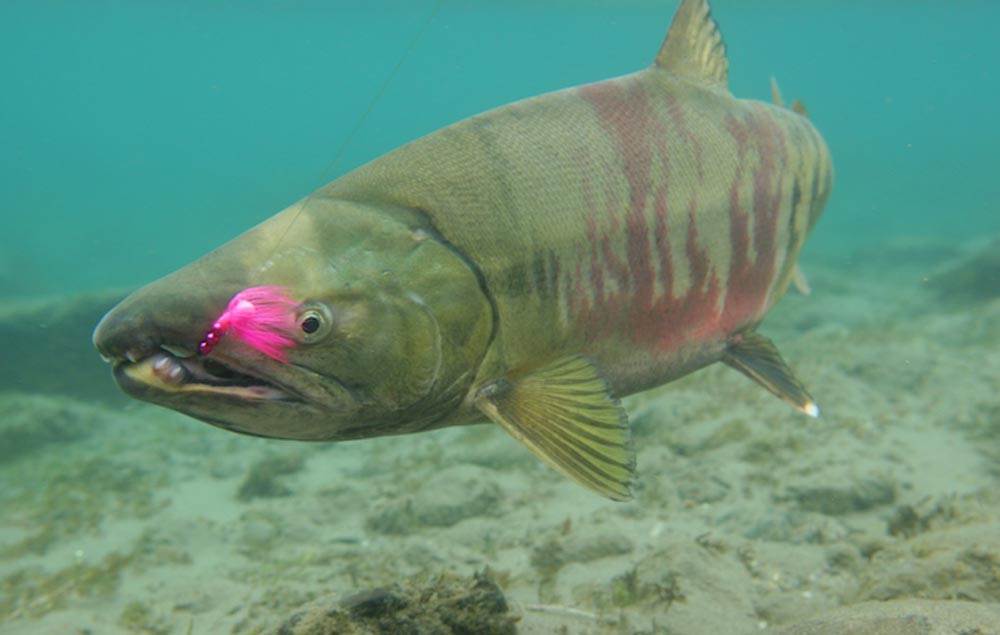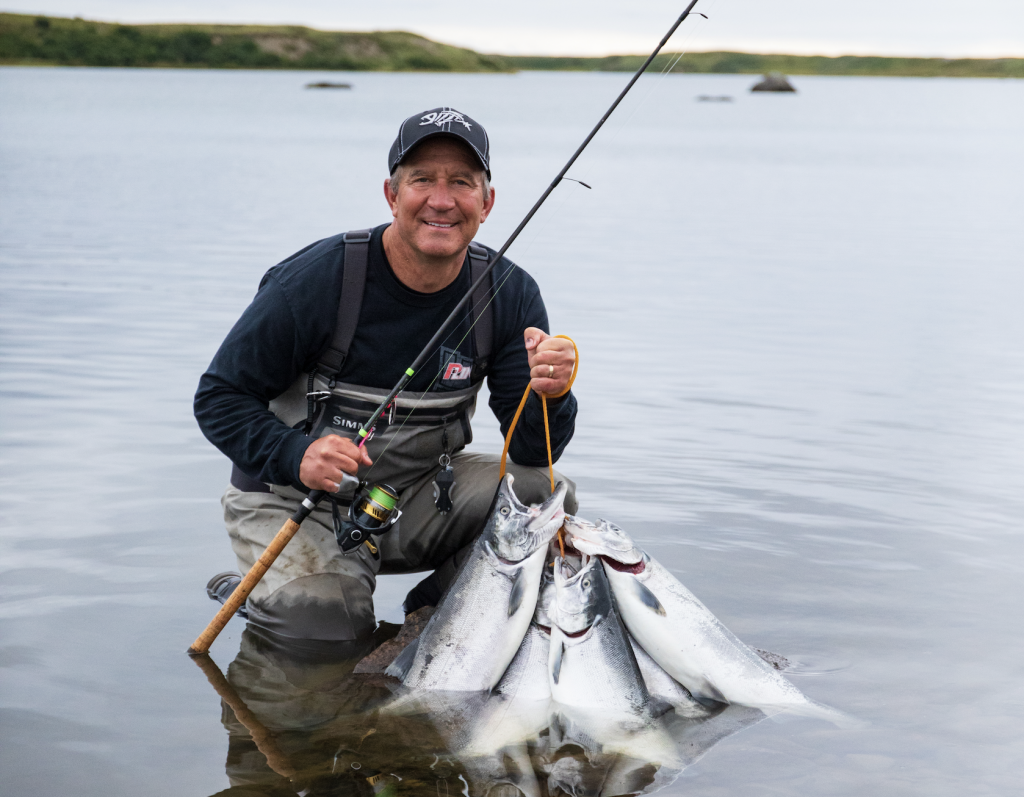 Location: Egegik River, Alaska
Location: Egegik River, Alaska
•NOW BOOKING FOR 2025
*Limit 8 anglers per Group
2025 Dates
Group 1 (fly in) July 31–August 5 (fly out)…(FULL)
Group 2 (fly in) August 2–August 7 (fly out)…(FULL)
Group 3 (fly in) August 5–August 10 (fly out)…(FULL)
Group 4 (fly in) August 7–August 12 (fly out)…(FULL)
Group 5 (fly in) August 10–August 15 (fly out)…(FULL)
Group 6 (fly in) August 12–August 17 (fly out)…(FULL)
Group 7 (fly in) August 15–August 20 (fly out)…(3 openings)
Group 8 (fly in) August 17–August 23 (fly out)…(FULL)
Group 9 (fly in) August 20–August 25 (fly out)…(FULL)
Group 10 (fly in) August 23–August 28 (fly out)…(FULL)
Group 11 (fly in) August 25–August 30 (fly out)…(FULL)
Group 12 (fly in) August 28–September 2 (fly out)…(FULL)
Group 13 (fly in) August 30–September 4 (fly out)…(6 openings)
Group 14 (fly in) September 2–September 7 (fly out)…(FULL)
Species
Coho Salmon, Chum Salmon, Pink Salmon
Fly-outs for these species as well as Arctic Grayling, Arctic Char and Rainbow Trout
Cost
$4,850 per person: Includes roundtrip bushplane flight from King Salmon, 5 nights at lodge, 5 full days of fishing (you can fish on arrival and departure days as flights & weather allows).
*(This prices does not including round-trip commercial airfare or fishing license)
**Cancellations receive full refund within 90 days of departure, or deposit will be rolled over to the following year or forfeited.
Overview
We are pleased to announce this camp on the Egegik River is under new management, as of September 2019. I’ve been fortunate to travel throughout many places in remote Alaska over the past 31 years, and I rank the coho fishing on the Egegik River to be among the best of the best. While silver salmon fishing is outstanding, the wildlife, scenic views, and tranquility make this the ultimate coho fishing adventure. Chum salmon in excess of 20 pounds are regularly caught on the Egegik River, as are Arctic char up to eight pounds or more. The Egegik River is a wide yet very gentle, simple river to wade-fish. Bushplane flyouts are affordable and easy to arrange whether you want to target trophy Arctic char, record-class Arctic grayling, or view brown bears up close.
Fishing On Alaska’s Egegik River
The first time I fished this river, with the only outfitter based on the Egegik at the time, I was hosting a TV show for the Outdoor Channel. We filmed three shows in two days. In one of those episodes I stood on a single rock, showed four different ways to fish for silver salmon, and landed and released over 70 fish. My last trip to this river, 10 years later, was just as good, if not better.
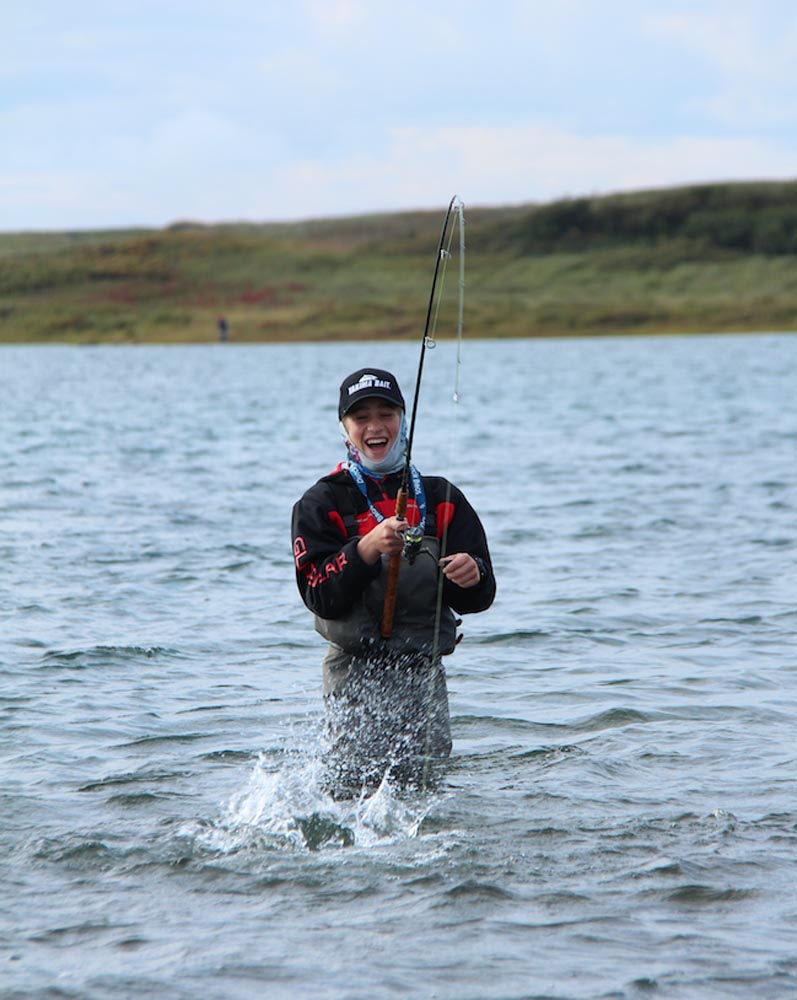 The Egegik River flows out of Becharof Lake, Alaska’s second largest lake. It’s a slow-flowing river consisting of a gravel bottom. This makes for some of the easiest wade-fishing you’ll ever find.
The Egegik River flows out of Becharof Lake, Alaska’s second largest lake. It’s a slow-flowing river consisting of a gravel bottom. This makes for some of the easiest wade-fishing you’ll ever find.
Whether you’re an expert flyfisherman, handling a fly rod for the first time, or an experienced Spey caster, you will catch fish. Gear anglers will find success fishing with lures, twitching jigs, casting plugs, drifting eggs, using bobber and eggs, fishing beads and even casting plugs.
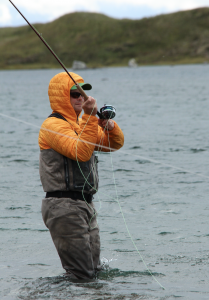 The topwater action for silver salmon on poppers is exciting and productive. Having dozens of takes a day on poppers is common, for both fly and gear anglers. One thing the Egegik River is designed for is Spey fishing. The Egegik River is wide, flat, easy to wade, and the banks are clean, meaning it’s easy to achieve prime casting positions. If it’s windy, there are enough turns and bends in the Egegik River where you’ll have no trouble finding a place to toss a line.
The topwater action for silver salmon on poppers is exciting and productive. Having dozens of takes a day on poppers is common, for both fly and gear anglers. One thing the Egegik River is designed for is Spey fishing. The Egegik River is wide, flat, easy to wade, and the banks are clean, meaning it’s easy to achieve prime casting positions. If it’s windy, there are enough turns and bends in the Egegik River where you’ll have no trouble finding a place to toss a line.
For gear anglers, catching and releasing over 50 silvers a day is very doable. On even numbered years, pink salmon arrive in huge numbers, and catching 100 of them a day is common. Chum salmon over 20 pounds frequent the Egegik River.
When conditions are right, you can motor into the headwaters of the Egegik River, where it flows from Becharof Lake. Here you can wade along both the northern and southern shores, casting for coho in one of the most beautiful settings in Alaska. You might also have the opportunity to fish the lake’s outlet from a boat, where you’ll be able to count silver dollar sized rocks 50-feet deep, and cast for schools of coho gathering by the hundreds.
In the upper part of the river, wade-fishing around the islands for Arctic char is very productive. Here, floating beads and working flesh fly imitations can find you battling gorgeous char measured in pounds, not inches.
Flyouts by float plane or wheel plane can also be arranged to some of Alaska’s most remote, prized streams. Here you’ll pursue some of Alaska’s biggest Arctic char and Arctic grayling, as well rainbow trout, sockeye salmon, and silver salmon. Bead fishing and flyfishing with egg and flesh fly patterns are the norm. With char weighing in excess of 10-pounds, and grayling stretching the tape to over 20-inches, most anglers like going on at least one flyout fishing adventure for these trophy fish during their stay at this camp.
With a daily limit of five coho, you’re assured of bringing home plenty of great eating meat. Each angler is allowed to take home one 50-pound box of fish. Due to bushplane costs and the logistics of getting large amounts of fish from camp to the freezers in King Salmon, the amount of fish anglers can bring home is limited to one box. However, if angler numbers in camp are low, and a bushplane can stop by camp while shuttling anglers from other camps or is making a flyout from our camp, they can often take more fish back with them which means anglers can take home an extra box of fish, or 100 pounds, total.
Brown bear viewing is one of the main attractions at this remote camp. While you’ll often see brown bears while fishing the Egegik River, if you want to see these giant predators of Alaska, up close and personal, consider a trip to Brooks Falls. Brooks Falls is home to the largest concentration of brown bears in the world during our fishing season. Here, brown bears gather to fish for sockeye salmon, and later, silver salmon. Many of our customers make this a yearly ritual, where they commonly see over a dozen big brown bears in a day; sometimes three times that many bears when the timing is right.
- Chomp!
- Brown Bear Fight
- Shake it off!
- Dinner…
- Brooks Falls

The Camp
 This fishing camp on Alaska’s Egegik River is under new management and has undergone a recent structural upgrade which I’m very excited about. In an effort to improve upon the quality of this remote camp, the new managers have built wood frame structures with all the amenities, to replace the weatherport style tents. These changes were largely based on years of client suggestions, which the new managers have taken to heart.
This fishing camp on Alaska’s Egegik River is under new management and has undergone a recent structural upgrade which I’m very excited about. In an effort to improve upon the quality of this remote camp, the new managers have built wood frame structures with all the amenities, to replace the weatherport style tents. These changes were largely based on years of client suggestions, which the new managers have taken to heart.
The camp is perched atop a hill overlooking the beautiful tundra to the West, and the breathtaking Egegik River to the East. From here it’s not uncommon to see brown bear, wolves, ptarmigan and if you’re lucky, an active volcano.
In the new cabins you’ll find rooms that sleep from 1-4 people, beds and all bedding, including pillows (there is no need to bring a sleeping bag). Hot showers and flush toilets are available in their own building, next to the main dining hall, rooms, & comfortable gathering areas. Internet service is very limited, but sometimes available in the evenings. There is no cell service, but the camp does have a satellite phone for emergency situations.
Each morning you’ll eat breakfast, where everyone gathers for coffee, then you’ll be fishing on the river just after daylight; even though this is remote Alaska and the coho salmon are not pressured, the best bite is still in the morning, day in and day out, year after year. A shore lunch of fresh-caught coho is usually on the menu, whipped-up by the longtime cook and one of the best I’ve seen in my more than 30 years of traveling throughout remote Alaska. These great lunches are prepared differently, every day. By 4:00 in the afternoon, folks are usually ready to head back to the main camp for a shower, appetizers and happy hour. A big dinner follows, with something tasty and different, every night.
Other Costs
•Nonresident 7 day sport fishing license, $45.00
•Flyout fishing & brown bear viewing is about $650 per person and is subject to bushplane regulation.
•Tips
Travel Planning
You will book your flight on Alaska Airlines, as they partner with carriers who will take you from Anchorage to King Salmon. Book flights so you arrive in King Salmon as early as possible on your first day, and leave King Salmon as late in the afternoon/evening as possible on your last day. For example, if your fishing dates are August 3-8, arrive in King Salmon as early as possible on Aug. 3, and arrange to leave King Salmon as late as you can on Aug. 8. This will allow plenty of time for the bush plane transfers, should there be issues with weather, unforeseen schedules, etc. Sometimes folks are salmon fishing on the evening of their arrival, as well as on the morning of their departure, and both of these times are considered bonus days on the water at no extra charge. Due to travel uncertainties due to Covid, many customers choose to overnight in Anchorage the night prior to arriving in camp, then hop on the flight to King Salmon early the next morning, which means they’ll arrive in camp early in the afternoon which allows plenty of time to start fishing. Be aware that overnighting in King Salmon costs about $300 per person, should you choose that option.
Once you arrive in King Salmon, you’ll be met by our bush plane service, which we will give you the name/contact information of prior to your departure from home. They’ll help you gather your luggage and get you to the plane for the 30 minute flight to camp. The price of the bushplane is included in your trip costs.
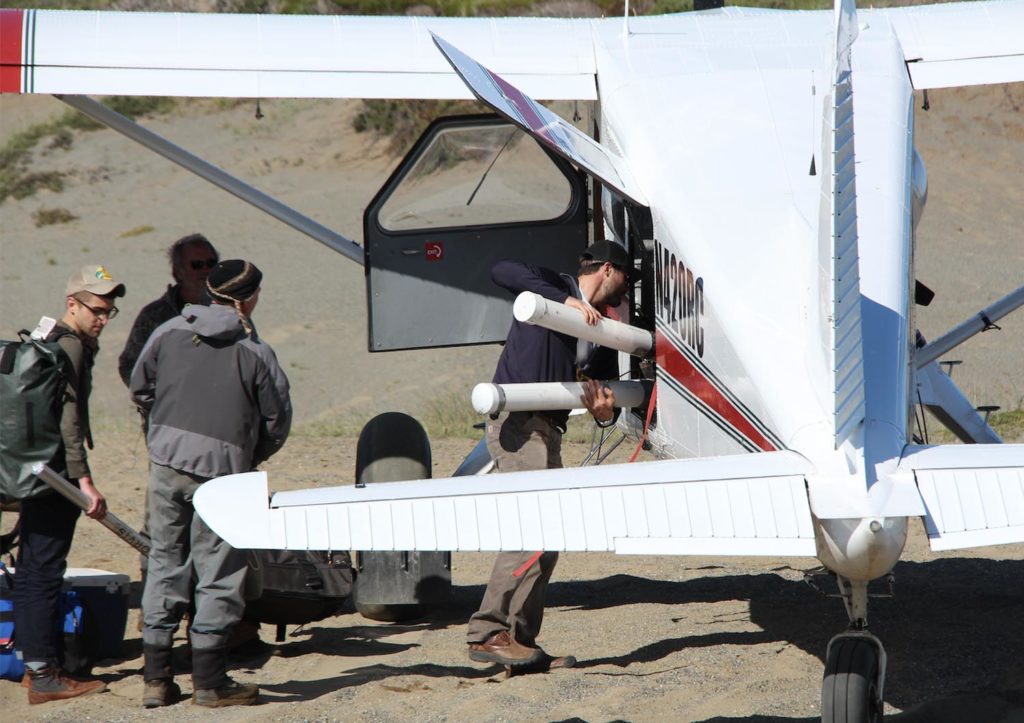
GEAR LIST FOR THIS TRIP
Personal Items
•Breathable Waders & Wading Boots (no felt soles) •Wading/Rain Jacket •2 Base Layers
•Hooded Sweatshirt •1 Pair of Pants•1 Pair Warm Sweatpants for waders and around camp
•3 Underwear & Socks •Stocking Hat •Ball Cap •Ear Plugs •Thin Gloves
•2 Long Sleeve Shirts •Sunglasses •Lip Balm •Camp Shoes •Toiletries •Medicines
•Camera (battery chargers) •Small Waterproof Bag •Phone/Charger
•Cash For Tips •*2 medium sized duffle bags
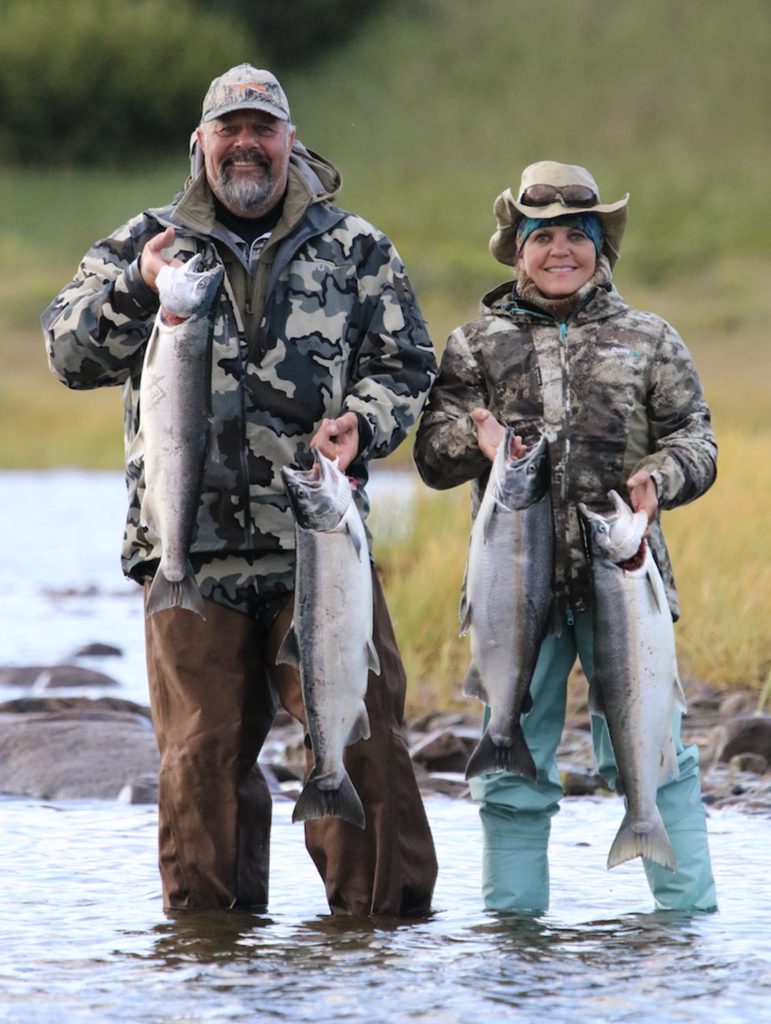
Fishing Gear
Note: The lodge supplies all spinning rods, gear and tackle at no cost. If you want to bring your own gear to fish multiple ways, following are some suggestions:
•**Rod case
•3 spinning rods 8’-9’6” with a line rating of 8-17 lb. test.
•2 spinning reels spooled 12 pound test line.
•1 spinning reel spooled with 20-30 pound braided line that floats.
•1 bait casting rod with a line rating of 8-17 lb. test (optional).
•1 bait casting reel spooled with 12 pound test line (optional).
•1-2 dozen lures in the 1/2-ounce to 3/4-ounce range with pink and chartreuse being the best colors. Good coho spinners are Flash-Glo Casting Spinners, Rooster Tails, Blue Fox Vibrax, Pixee, Mepps Flying C, Mepps Aglia and other similar styles/brands.
•One package of 4” pink rubber worms.
•1 dozen Snap swivels •Hook File •Nail Clippers (for cutting line)
•Small Pliers (needle nose that cut line and lead)
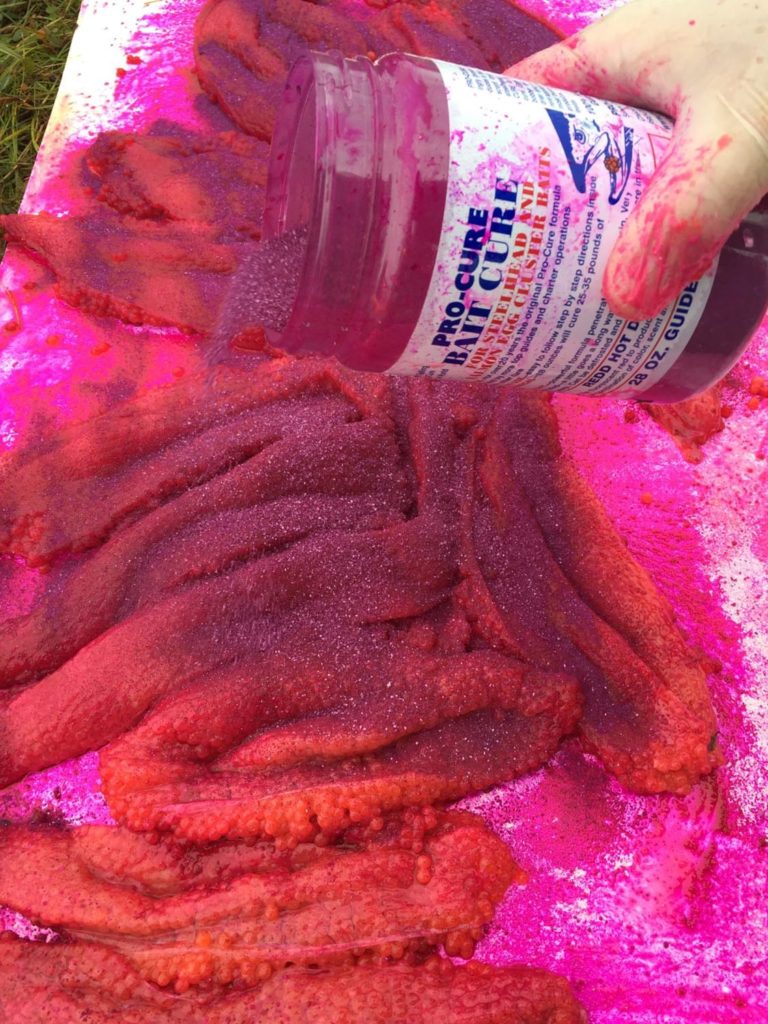 Eggs can be fished on the Egegik River, so if you’re an egg fisherman, bring:
Eggs can be fished on the Egegik River, so if you’re an egg fisherman, bring:
•24 pre-tied leaders on 2/0-3/0 Octopus style hooks on 15 lb. test, 24”-36” long.
•Extra egg hooks (2/0 or 3/0 Octopus style).
•1 spool of 12 lb. test line (150 yards, in case of loss, tangle or leaders).
•Fishing yarn (pink, orange, green).
•10, Lil’ Corkies, (pinks, chartreuse, size 10).
•6, Spin-N-Glos, (pink, chartreuse, size 8 or 10)
•1 dozen Barrel swivels (size 7).
•Sinkers (slinky, pencil lead (hollow core), even larger split-shots are great). You don’t need much lead as the river is shallow with few hangups.
•A bottle of egg cure and a dozen sealable bags (optional).
This is an excellent river to Jig Fish, so bring:
•3 floats/bobbers, 1/8-ounce.
•6 bobber stops & 3mm beads
•A dozen 1/8-ounce to 1/4-ounce jigs (in various shades of pink with a couple chartreuse).
•6 twitching jigs, 1/2-ounce.
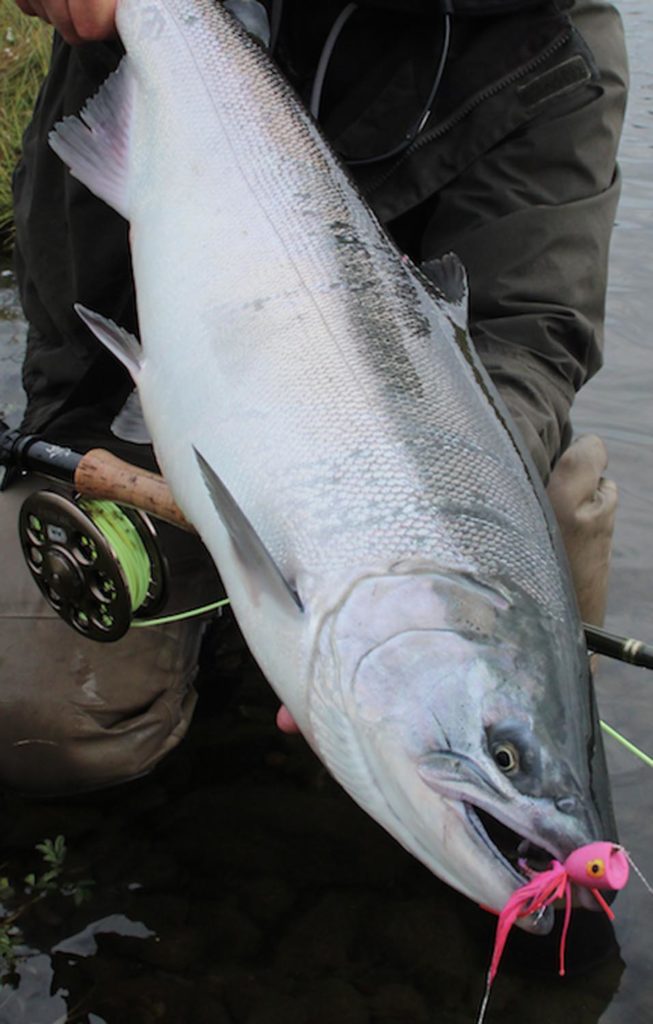
Flyfishing Gear
•7 /8 or 8/9 weight fly rod.
•Reel with good drag spooled with floating line.
•10-12 pound tippet/leader.
•Assortment of Teeny Nymph Egg-Sucking Leech Flies, size 4 & 6, in Hot Pink, Chili Red & Flame Orange
•1 pack of Cabela’s 12-Piece Coho Assortment flies and poppers.
•Leech, Shrimp, and Streamers in size 2, 4.
•3 Popperwogs, size 2, pink.
•3 Hammerhead Hair Wogs, size 2, pink.
•3 Polywog (foam-top), size 2.
Pack light, as weight and space are valuable on bushplanes. The smaller your checked bag, the better. We suggest wearing one set of clothes you’ll fish in and bringing only one other set of clothes. A light pair of camp shoes is a good idea, as is an extra pair of socks and underwear. When you arrive at the bushplane you may need to get your waders and rain jacket out to wear on the flight to camp, as it’s a short boat ride from the plane to the lodge and it could be raining. Your bushplane pilot will let you know.
The outfitter supplies cooler bags for shipping fish home. Each cooler bag holds up to 50 pounds of salmon. Some people bring a cooler to take fish home in; a 48-quart cooler holds 50 pounds of vacuum sealed salmon. You can pack your waders and clothes inside a duffle bag and place in the cooler on the way up, then you’ll have two bags ready to go for the trip home.
**The lodge supplies all rods, reels, and tackle, but some folks like bringing their own rods. For fishing rods, you can carry on 4-piece rods, or put them in a checked bag. If bringing 2-piece rods, get a 6” to 8” diameter section of PVC pipe (the tube should be about 1-foot longer than the longest rods you’ll be bringing, when broken down). Get two caps for the PVC tube. Glue one cap on to one end the PVC tube. Drill a hole into the end of the other cap to prevent airlock. This cap will be taped to the tube for travel. Duck tape a piece of rope to the tube for a handle, and you’re set. Slip each rod into a cloth case, then fit them together and slide them all into the tube at the same time. There will be extra room for small items, even clothes, to fill in the gaps inside the tube. This way you have only one checked bag for all your rods. You can also place rods in their own rod case, then duck tape them together so there’s only one bag to check.
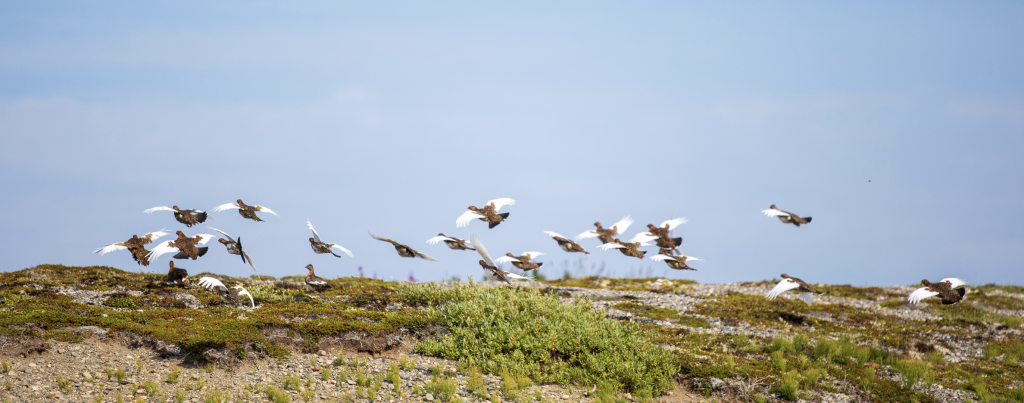
CAST & BLAST ADVENTURE FOR COHO SALMON & WILLOW PTARMIGAN
Looking for a fun cast and blast adventure in Southwest Alaska? Willow ptarmigan season opens August 10th in this part of Alaska. The daily bag limit is 10 birds. Because willow ptarmigan populations can fluctuate, this can be opportunistic hunting, depending on the year and winter survival rates of willow ptarmigan along this part of the Alaska Peninsula. The past few years have seen a growing number of willow ptarmigan around the lodge, as well as up and down the banks of the Egegik River. Due to park boundaries and local landholdings, a two mile hike from the lodge is necessary to reach grounds where willow ptarmigan can be hunted. The lodge can also drop you off by boat, where you can then hike and hunt for as long as you’d like, returning to the lodge at your leisure.
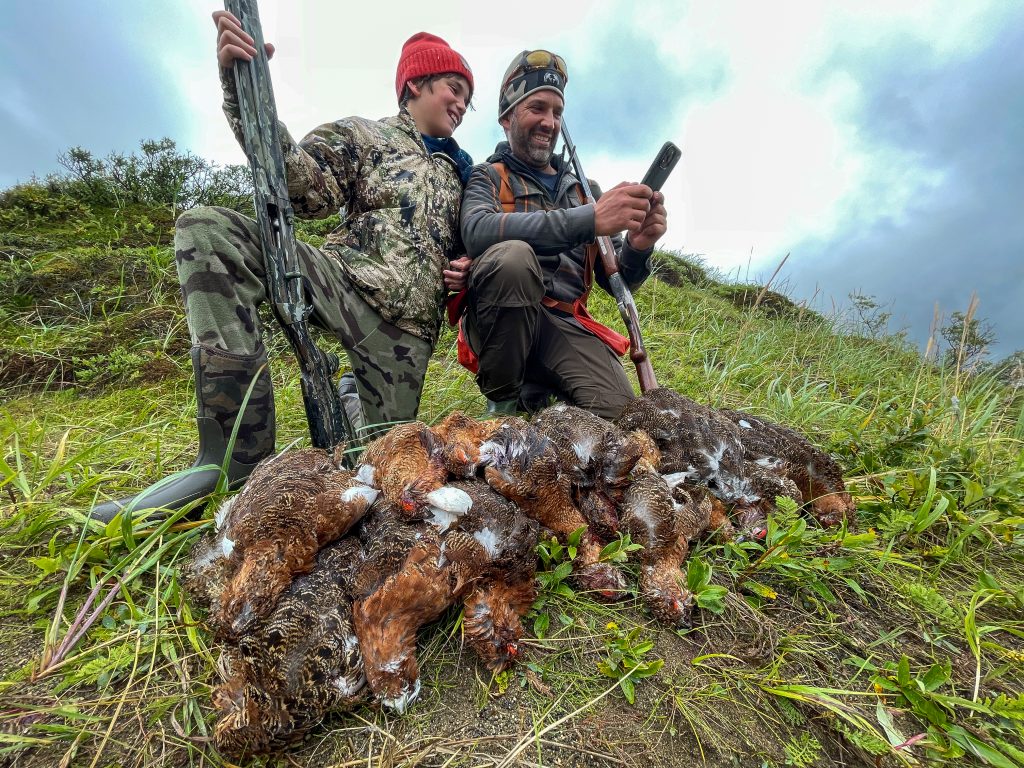 These are non-guided, do-it-yourself hunts for willow ptarmigan. Because the tundra is flat and the terrain, wide open in this part of Alaska, navigation is simple. Key landmarks and/or the lodge are always in sight, meaning you won’t get lost. Leather, waterproof hiking boots are all you need to traverse the tundra.
These are non-guided, do-it-yourself hunts for willow ptarmigan. Because the tundra is flat and the terrain, wide open in this part of Alaska, navigation is simple. Key landmarks and/or the lodge are always in sight, meaning you won’t get lost. Leather, waterproof hiking boots are all you need to traverse the tundra.
The hiking is very easy, thanks to the firm, sandy and rocky soil making up the tundra in this part of Alaska. It’s simple to walk five to eight miles a morning, even more, chasing willow ptarmigan on the open tundra. Early in the willow ptarmigan season, family flocks of can be found foraging on various berries and vegetation. During high winds, flocks of willow ptarmigan will often gather in depressions in the tundra, and around alder thickets, making for high success spot-and-stalk hunting. By late August, flocks of willow ptarmigan begin to build into winter flocks. At this time, seeing 50 or more willow ptarmigan in a single flock is common.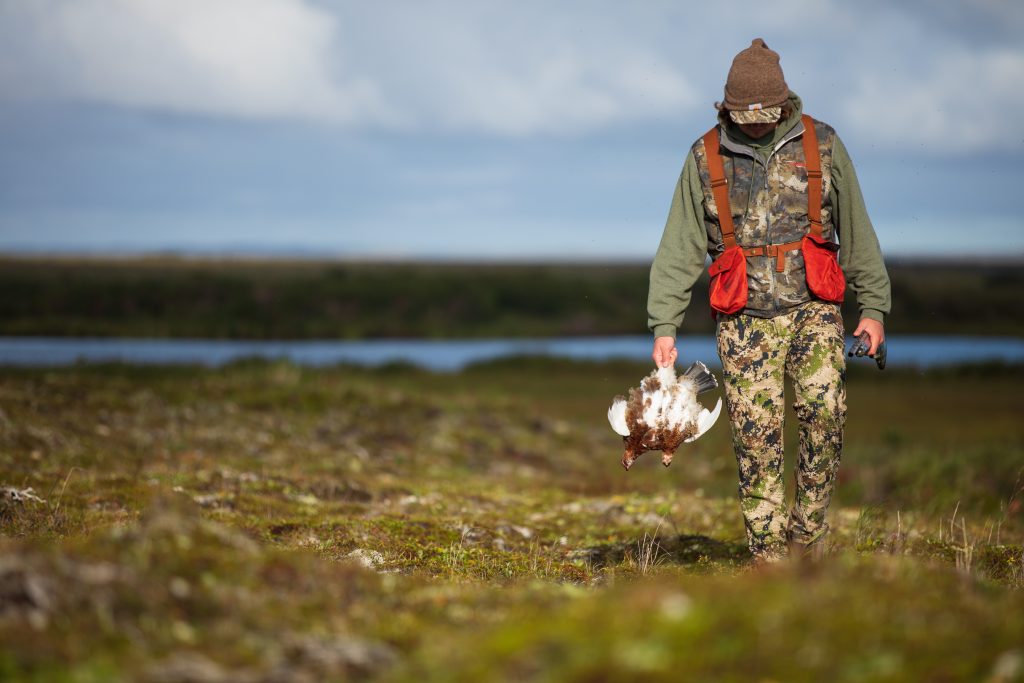
The lodge has 20 gauge shotguns to borrow. Sometimes shotgun shells are also available through the lodge, but not always. Plan on bringing two or three boxes of non-toxic shot, with size 5 or 6 shot being ideal.
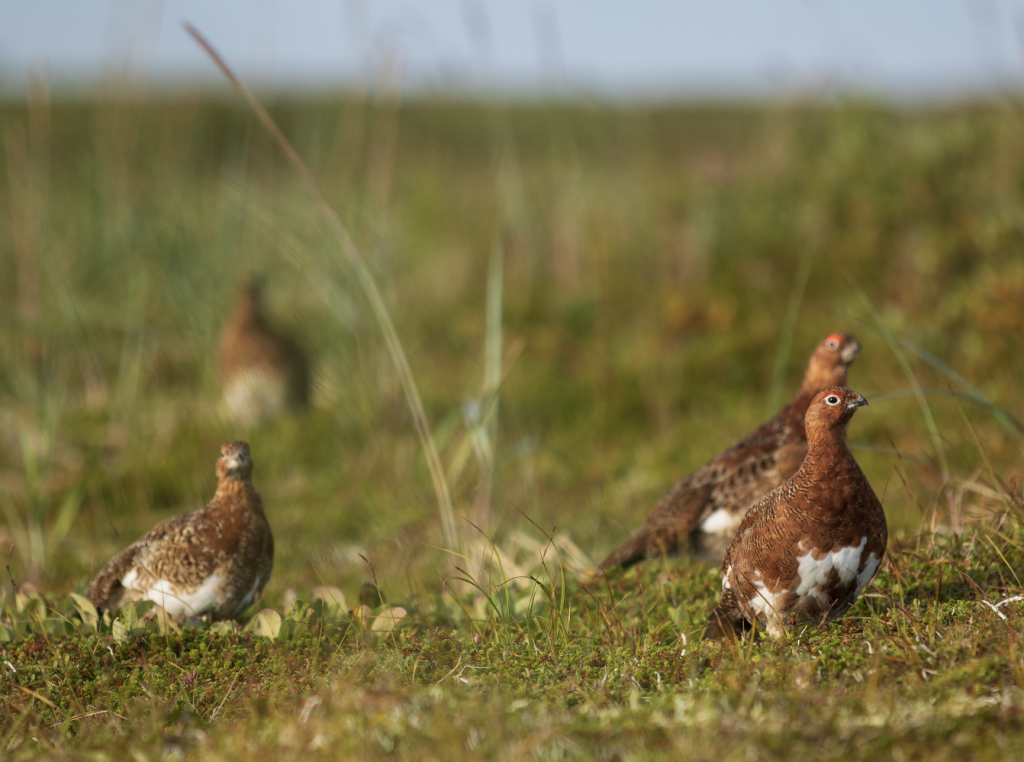 Please keep in mind this is not a high-volume hunt for willow ptarmigan, meaning the intent is not to shoot limits of willow ptarmigan every day of your stay. This is selective hunting meant to provide a fun bonus to your remote Alaska coho salmon fishing experience. But bagging a couple limits during your time in camp is often doable. These birds are typically cleaned by the hunter–in the field so as not to attract brown bears around the lodge–then given to the cook to prepare as appetizers for others in camp to enjoy. Some hunters enjoy shooting two or three willow ptarmigan, then cooking them over and open fire on the tundra. Early season willow ptarmigan is considered by many seasoned upland bird hunters to be among the best eating game bird there is.
Please keep in mind this is not a high-volume hunt for willow ptarmigan, meaning the intent is not to shoot limits of willow ptarmigan every day of your stay. This is selective hunting meant to provide a fun bonus to your remote Alaska coho salmon fishing experience. But bagging a couple limits during your time in camp is often doable. These birds are typically cleaned by the hunter–in the field so as not to attract brown bears around the lodge–then given to the cook to prepare as appetizers for others in camp to enjoy. Some hunters enjoy shooting two or three willow ptarmigan, then cooking them over and open fire on the tundra. Early season willow ptarmigan is considered by many seasoned upland bird hunters to be among the best eating game bird there is.
Willow ptarmigan can be hunted all day, but the best action is usually early in the morning. This is when flocks of willow ptarmigan can be heard calling across the tundra. While willow ptarmigan are masters of camouflage, their wing feathers are white, year-round. This makes spotting willow ptarmigan as they fly and move around to feed on the open tundra, straight forward. Some guests take off hiking from the lodge at sunup, then spend the afternoon fishing for coho salmon on the Egegik River. Others like getting on the early morning coho bite, which is always the best time to catch coho on the Egegik River, then go hunting for willow ptarmigan once they’ve caught their five coho limit.
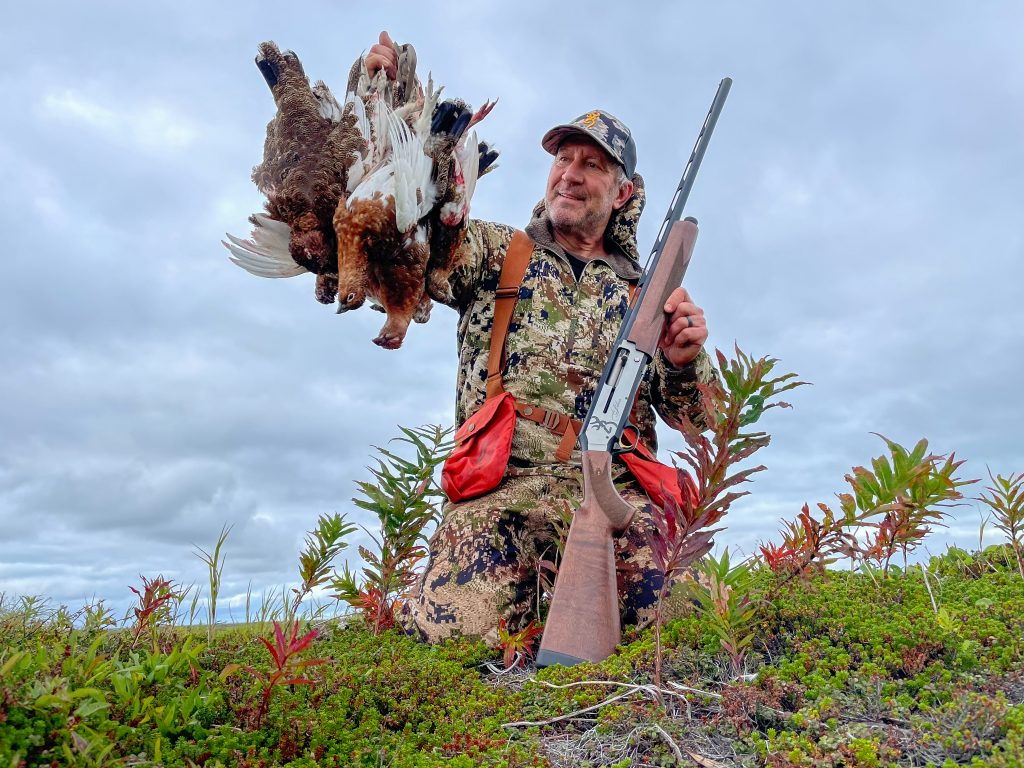 Most guests are content with one good ptarmigan hunt during their stay. There is no extra charge for ptarmigan hunting, nor is there a gun rental or shotgun shell usage fee. If you do plan on hunting willow ptarmigan, brining a couple boxes of steel or bismuth 20 gauge shells will help keep them in stock, as they can be hard to come by once the season gets rolling.
Most guests are content with one good ptarmigan hunt during their stay. There is no extra charge for ptarmigan hunting, nor is there a gun rental or shotgun shell usage fee. If you do plan on hunting willow ptarmigan, brining a couple boxes of steel or bismuth 20 gauge shells will help keep them in stock, as they can be hard to come by once the season gets rolling.

